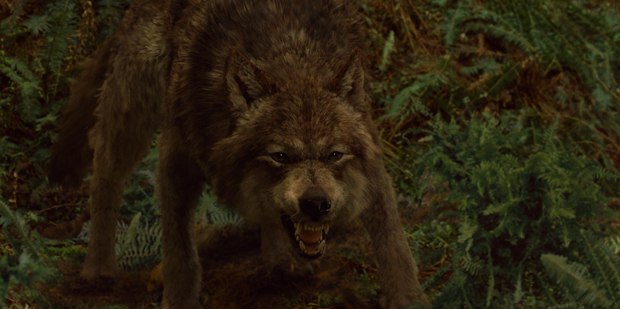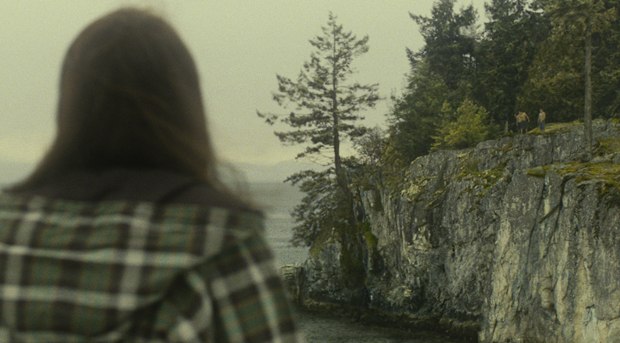Susan MacLeod and Phil Tippett discuss werewolves, "vampire speed" and "diamond skin" in the latest mega-smash, The Twilight Saga: New Moon.
Check out the New Moon trailer and making of clips at AWNtv!
Both the plot and blood thicken in The Twilight Saga: New Moon, which opened for Summit with $142.8 million last weekend, the best of 2009 and third best ever. While Edward (Robert Pattinson) and Bella (Kristen Stewart) part, Jacob (Taylor Lautner) takes his romantic shot with her, only discover that he's part of a werewolf pack sworn to protect humans from vampires.
New to The Twilight Saga is Susan MacLeod, visual effects producer turned supervisor, who joins director Chris Weitz after collaborating on the Oscar-winning Golden Compass. Not surprisingly, she turned to Prime Focus and Tippett Studio, given their expertise with particles and character animation, respectively, as well as her previous associations with them (Prime Focus President Mike Fink supervised The Golden Compass, and Tippett has worked with her on several movies, including Golden Compass).
"For this movie, I knew [transitioning from visual effects producer to supervisor] could work because of the relationship that Chris and I have," MacLeod suggests. "I was scared at the beginning, as anyone would be the first time that you take on a responsibility that you haven't had before. But I have been around a while, which is a good thing, but, most importantly, the volume of work is not even remotely overwhelming to me, having come from movies that had four times as many shots.
"But the most daunting thing about making this movie really was the schedule. From start to finish for me, it was less than 10 months. To me, it was extraordinarily quick -- but refreshing and rather concerning, too. There are certain things that you can't do faster, no matter how much the studio might want. Initially, they pushed us to deliver a trailer shot early, which I begrudgingly agreed. And then, of course, two months before we were supposed to deliver that trailer shot, they decided that they needed it a month earlier. Personally, I was very unsatisfied with that trailer shot, but I understand that there's a marketing machine that needs to be fed, and it was definitely fringing on the impossible, there."
However, they were turning over vfx shots involving 3D animation and matchmoving before they finished shooting in order to get a pipeline started. "The methodology we came up with for [Edward's] apparitions was isolating Rob on a greenscreen and in some instances we could shoot that in the environment on location and just lock off the camera, and in other situations, though, we needed to shoot wild moves on location, and then pick a select, matchmove that select and then feed that matchmove to a motion control rig. So those were also shots that we were essentially turning over while we were still shooting them because we had to create the matchmoves in order to shoot the greenscreen element. So, it's always fun to do production and post-production at the same time, when the schedule necessitates it."
New Moon contains about 400 shots, the majority of which (175) were done by Prime Focus under the supervision of Eric Pascarelli. These consist of the "diamond skin" sparkling effect of Edward and the other vampires (when coming into contact with sunlight), along with an assortment of CG water, atmospherics, CG matte painting and various environments.
"There is a very fine line between applying an effect to this beautiful kid's skin that makes it look pretty as opposed to a skin disease," MacLeod insists. "And that was quite a development process, as you could imagine. We also had some cracking skin vampire effects and the apparition effect of Rob and also some invisible work as well."
The Prime Focus team used Greek Thassos marble as its inspiration: a very white, translucent material with flecks that reflect light very efficiently. The team even had a slab at the office for the CG artists to use as reference.
"It was challenging because the diamond effect appears in sunlight, whenever Edward's already very pale skin is lit by sun, and on top of all of that brightness, there needs to be a convincing diamond-like sparkle," Pascarelli explains in the production notes. "Film doesn't really have enough brightness range to do this, so we had to resort to some trickery, such as lens effects, flares and light rays to give the feeling of super-bright glimmer. In addition to all of that, we needed to show the skin having a translucent glow. There was a very delicate balance of the elements that make up the effect. We used 3D particle geometry dispersed over a CG model of Edward's head to reflect several artificial environments in order to create the sparkles and rays. Chris and Susan loved what we came up with very early in the process, which ended up being one of the happy surprises during production."
Prime Focus' Vancouver studio also collaborated with its Digital Matte Painting department in Los Angeles (headed by Ken Nakada) on recreating the movie's Forks High School, as well as craggy cliffs overlooking the ocean and other full-CG environments depicting the movie's Washington State locale. Prime Focus additionally contributed CG water for multiple scenes and two elaborate time passage sequences featuring Bella in complicated multipart motion control shots.
For the cliff scenes, Nakada and his team designed the entire landscape using several locations in Vancouver's Whytecliff Park as reference. The team also provided on-set vfx supervision for MacLeod and Weitz on a greenscreen shoot at Vancouver Film Studios of a stuntman jumping 70 feet off a tower as a camera rig does a 270-degree tilt, following him from the top of the cliff until he hits water.
Prime Focus used Autodesk's Maya, 3ds Max and Mudbox for 3D modeling; eyeon Fusion for compositing; the proprietary Krakatoa for particle rendering; and Flood and Flood: Surf for fluid simulation.
Meanwhile, Tippett Studio did 60 wolf shots, with five different characters, broken up into four sequences (under the supervision of Phil Tippett with Matt Jacobs serving as co-supervisor).
"The werewolves are kind of the sentinel protectors of the area," Tippett explains. "And there's nothing from the werewolf mythology of the past: it's a curse of responsibility as the indigenous people of this country. But this gave us a chance to continue doing the dance with the talking, furry animals. So getting these wolves to behave and be lit and act in a convincing manner was our task here. These things are not the classic beasty werewolves, either. They're Timberwolves that are scaled up to be the size of the horse. One of the biggest tricks was to logistically turn a 6-foot tall guy into an 8-foot-long, 1,200-pound wolf. And there are three of these transitions in the movie. Surprisingly, we figured it out early enough.
"We engineered the performances of the actors and their pantomime leading up to the explosive moment because it's anger that motivates these people to actually shape shift into werewolves -- and it has to happen quick and everyone was on the same page with that. The only design adjustment was Chris wanted to have the eyes of the actors in the wolves' heads instead of the very distinctive, golden, wolf eyes."
Tippett additionally worked on what MacLeod calls the "vampire speed" effect, which involves the vamps running at superhuman speeds. "What we decided to do, based on some tests that we did," McLeod explains, "was to shoot any vampire in motion, as light would allow, up to 90 frames-per-second. And then we would take that into the Avid and manipulate that, come up with a speed ramp and then potentially enhance that with some post processing.
"That's where Tippett's effects came in for about a dozen shots we decided to do as a post effect. We did a little bakeoff and had a couple of companies do a test and Tippett had a good-looking test and we went with them. It was based on a happy accident that happened when they did a varied speed for the trailer shot, actually. They ran a Shake script that had a bug in it and the render came back and had an interesting liquid, transparent effect that happened to Taylor's body that resonated with Phil and Matt and they sent it to me. It was the visual equivalent of the sonic boom, in mind, where the person is moving faster than the camera can pick up.
"Then we had a recipe of stuff that did with vampire speed: we shot them stacked because we found that foreground trees were helpful, so with the wolves, we added some foreground CG trees passing by; and, for the actress running through the woods, we shot her long lens with real trees in the foreground; and a few whip pan effects. The challenge was the wolves, so we tried not having wolves and vampires running in the same shot because that would necessitate either seeing the wolves running in slow-motion or speed up the vampires so that they're running at least as fast or faster than the wolves, but that looks silly, so when we ended up having wolves and vamps in the same shot, we used that Tippett post effect."
Bill Desowitz is senior editor of AWN & VFXWorld.











